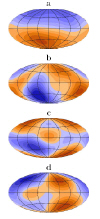Why are the magnetic fields of Neptune and Uranus different from those of the other planets?

A group of geophysicists may have solved one of the biggest mysteries in the solar system - why are the magnetic fields of Neptune and Uranus different from those of the other planets? Computer simulations by Sabine Stanley and Jeremy Bloxham from Harvard University raise the possibility that these two planets consist of a liquid core surrounded by a relatively thin outer layer. Earth and other planets such as Jupiter and Saturn have a rocky core, surrounded by a thick layer that conducts heat. The results of the research suggest that it will be possible to use the magnetic fields of planets to learn about their structure and composition.
The magnetic field of Earth, Jupiter and Saturn resembles a field that would be created if a giant magnet were placed in the center of the planet and roughly aligned with the axis of rotation. On Uranus and Neptune, on the other hand, the magnetic poles are arranged from the axis of rotation towards the equator. Furthermore, it turns out that the magnetic field of these planets is created by two north and two south poles.
The Earth's magnetic field is created by convection in the thick, liquid crust of the planet - made of molten iron and nickel. The crust surrounds a small, electrically conductive core. Similarly, the magnetic fields of Jupiter and Saturn are created by a thick layer of metallic hydrogen, which surrounds a small, rocky inner core.
Stanley and Bloxham developed a different model for Neptune and Uranus. They claim that the convection in these planets is carried out by a thin and liquid outer layer, which is apparently made of ice, containing water, methane, ammonia and hydrogen sulfide. This layer surrounds an inner core, made of a liquid that lacks the convective property. The computer simulations, based on this model, create magnetic fields similar to those photographed by the Voyager 2 spacecraft in the XNUMXs on Uranus and Neptune. "It shows how much we can learn about the interior of a planet by studying its magnetic field," Stanley told Physics Web.
